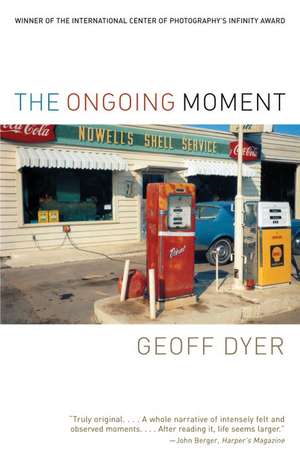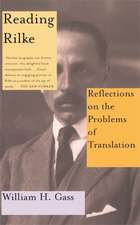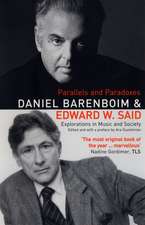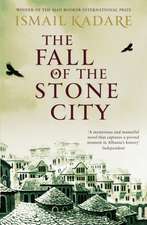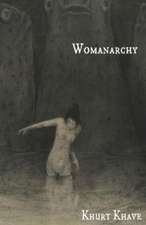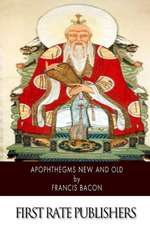The Ongoing Moment
Autor Geoff Dyeren Limba Engleză Paperback – 28 feb 2007
Preț: 112.60 lei
Nou
Puncte Express: 169
Preț estimativ în valută:
21.55€ • 22.26$ • 17.93£
21.55€ • 22.26$ • 17.93£
Carte indisponibilă temporar
Doresc să fiu notificat când acest titlu va fi disponibil:
Se trimite...
Preluare comenzi: 021 569.72.76
Specificații
ISBN-13: 9781400031689
ISBN-10: 1400031680
Pagini: 285
Ilustrații: 93 HALFTONES; 8 PP. COLOR
Dimensiuni: 134 x 202 x 17 mm
Greutate: 0.29 kg
Editura: Vintage Books USA
ISBN-10: 1400031680
Pagini: 285
Ilustrații: 93 HALFTONES; 8 PP. COLOR
Dimensiuni: 134 x 202 x 17 mm
Greutate: 0.29 kg
Editura: Vintage Books USA
Notă biografică
A Fellow of the Royal Society of Literature and a member of the American Academy of Arts and Sciences, Geoff Dyer has received the Somerset Maugham Award, the E. M. Forster Award, a Lannan Literary Fellowship, a National Book Critics Circle Award for criticism, and, in 2015, the Windham Campbell Prize for non-fiction. The author of four novels and nine works of non-fiction, Dyer is writer in residence at the University of Southern California and lives in Los Angeles. His books have been translated into twenty-four languages.
Extras
I am not the first researcher to draw inspiration from a ‘certain Chinese encyclopaedia’ described by Borges. According to this arcane work ‘animals are divided into: (a) those that belong to the Emperor; (b) embalmed ones; (c) those that are trained; (d) suckling pigs; (e) mermaids; (f) fabulous ones; (g) stray dogs; (h) those that are included in this classification; (i) those that tremble as if they were mad; (j) innumerable ones; (k) those drawn with a very fine camel’s-hair brush; (l) et cetera; (m) those that have just broken the flower vase; (n) those that at distance resemble flies.’
While the survey of photography undertaken in these pages can claim neither this degree of rigour nor eccentricity, it takes heart from earlier, well-intended attempts to marshal the infinite variety of photographic possibilities into some kind of haphazard order. Walker Evans said it was ‘a pet subject’ of his – how writers like James Joyce and Henry James were ‘unconscious photographers’. In the case of Walt Whitman there was nothing unconscious about it. ‘In these Leaves [of Grass] every thing is literally photographed,’ he insisted. ‘Nothing is poeticized.’ Keen to emulate the ‘Priests of the Sun’, Whitman created poems that, at times, read like extended captions in a huge, constantly evolving catalogue of photographs:
See, in my poems, cities, solid, vast, inland, with paved streets, with iron and stone edifices, ceaseless vehicles, and commerce,
See, the many-cylinder’d steam-printing-press – see, the electric telegraph stretching across the continent, [. . .]
See, the strong and quick locomotive as it departs, panting, blowing the steam-whistle,
See ploughmen ploughing farms – see, miners digging mines – see, the numberless factories,
See mechanics busy at their benches with tools [. . .]
For his part Evans, in 1934, compiled a list of picture categories as a way of clarifying his own ideas about what he was trying to do in his work:
People, all classes, surrounded by bunches of the new down-and-out.
Automobiles and the automobile landscape.
Architecture, American urban taste, commerce, small scale, large scale, clubs, the city atmosphere, the street smell, the hateful stuff, women’s clubs, fake culture, bad education, religion in decay.
The movies.
Evidence of what people of the city read, eat, see for amusement, do for relaxation and not get it.
Sex.
Advertising.
A lot else, you see what I mean.
The cultural historian Alan Trachtenberg has pointed out that this list calls to mind Lewis Hine’s earlier Catalogue of Social and Industrial Photographs, ‘only seasoned with Evans’s irony’. But it’s more than irony that sets the two endeavours apart. Hine’s is an entirely logical and rigorous listing – ‘Immigrants’, ‘Women Workers at Work’, ‘Men Workers at Work’, ‘Incidents of a Worker’s Life’ and so on – comprising over a hundred topics and more than eight hundred sub-topics.* A model of orderly arrangement and organization, it is entirely lacking in the provisional, highly contingent and ultimately unsustainable (‘a lot else’) quality of Evans’s catalogue of his own intentions.
Some of Evans’s best-known work was done under the auspices of the Farm Security Administration between 1935–37. Known first as the Resettlement Administration, this was one of Roosevelt’s New Deal agencies aimed at improving the lot of poor farmers and sharecroppers brought to the brink of starvation by the Depression. The FSA was headed by the economist Rexford Tugwell who, in 1935, appointed his old teaching assistant Roy Stryker to run the Historical Section. Both men were convinced of the power of photographs to give a human reality to economic arguments but it was not until the fall of that year, when Stryker was granted sole responsibility for making a photographic record of the agency’s policy and work, that he got a clearer sense of his task – and of his power. This was brought into still sharper focus when he saw some photographs that had already been commissioned. They’d been done by Evans and were sufficiently impressive to secure the photographer the post as Stryker’s Senior Information Specialist. Evans viewed this appointment as a kind of ‘subsidized freedom’, but, like many of the other photographers working for Stryker (Ben Shahn, Dorothea Lange, Russell Lee, Arthur Rothstein, among others), he found his freedom compromised by the patron who had bestowed it. As Stryker’s sense of his mission grew he issued more and more exacting ‘shooting scripts’, broken down by season, often sub-divided by location, itemizing in extraordinary detail what he wanted photographing. Here is an excerpt from a script for ‘Summer’:
Crowded cars going out on the open road. Gas station attendant filling tank of open touring and convertible cars.
Rock gardens: sun parasols; beach umbrellas; sandy shores with gently swelling waves; whitecaps showering spray over sailboat in distant horizon.
People standing in shade of trees and awnings. Open windows on street cars and buses; drinking water from spring or old well; shady spot along bank – sun on water beyond; swimming in pools, rivers, and creeks.
Under ‘American Habit’, photographers of ‘Small Town’ life were instructed to look out for: ‘R.R. station – watching the train “go through”; sitting on the front porch; women visiting from porch to street; cutting the lawn; watering the lawn; eating ice-cream cones; waiting for the bus . . .’ In the ‘City’ they were pointed towards ‘park bench-sitting; waiting for street car; walking the dog; women with youngsters in park or sidewalk; kids’ games . . .’ All of this was to be supplemented by ‘General’ shots: ‘‘‘fill ’er up” – gas in car; “flats fixed”; traffic jam; detour sign; “Men Working” . . . Orange drink. Bill posters; sign painters – crowd watching a window sign being painted. Sky writing . . . Parade watching: ticker tape; sitting on curb . . .’
There is a particular poetry – the poetry of comprehensive contingency – about these scripts, and the fact that they now read as captions shows how diligently, if begrudgingly, Stryker’s photographers did his bidding. Stryker supplemented his scripts with still more precise orders to make good any omissions. ‘Where are the elm-shaded streets?’ he asked Russell Lee, in Amarillo, Texas, in 1939. On another occasion Lee was asked to look out for ‘a small town barber shop where they still have the individual [shaving cream] cups with Mr Citizen’s name on each cup’. Having told Arthur Rothstein, in Denver, to look out for ‘Raking and burning leaves. Clearing up the garden. Getting ready for winter’, Stryker added, as an afterthought: ‘Don’t forget people on front porches either.’ While fulfilling Stryker’s orders photographers such as Evans and Lange brought their own private agendas to bear so that, at times, the resulting pictures represent a hybrid or merging of distinct categorical requirements.
In the 1950s Evans became friendly with the young Swiss photographer Robert Frank whom he encouraged to apply for a Guggenheim fellowship. In support of his application Frank came up with his own, highly individualized list of things he might photograph:
a town at night, a parking lot, a supermarket, a highway, the man who owns three cars and the man who owns none, the farmer and his children, a new house and a warped clapboard house, the dictation of taste, the dream of grandeur, advertising, neon lights, the faces of the leaders, and the faces of the followers, gas tanks and post offices and backyards . . .
When the fellowship was awarded in 1955 Frank set out on a road trip across America, in the course of which he exposed nearly seven hundred rolls of film. After printing three hundred negatives Frank arranged the pictures into categories such as ‘symbols, cars, cities, people, signs, cemeteries . . .’ By the time the resulting book, The Americans, was published (in France in 1958; in the States the following year) only traces of this preliminary order could be seen. There were still pictures of cars and cemeteries but the book was no longer arranged around the intended categories.
In the full knowledge that there are other, more sensible ways to organize a book I take my cue from these highly contingent, provisional, often abandoned attempts rather than the methodical approach of Hine. As Robert Frank put it in his Guggenheim application, ‘the project I have in mind is one that will shape itself as it proceeds, and is essentially elastic.’ Dorothea Lange also believed that ‘to know ahead of time what you’re looking for means you’re then only photographing your own preconceptions, which is very limiting.’ As far as she was concerned it was fine for a photographer to work ‘completely without plan’ and just photograph ‘that to which he instinctively responds’. Taking Lange at her word I tried as far as possible to be open to anything, ‘like a piece of unexposed, sensitized material’. Certain pictures caught my eye, just as certain things happened to catch the eye of the photographers who took them in the first place. Initially chance played a key part in both processes. After a point, though, I began to see that a number of these photos had something in common – a hat, say – and once I became aware of this I started to look out for pictures of hats. I wanted my take on photography to be arbitrary, incidental, but at some point things necessarily coalesced under particular areas of interest. As soon as I realized I was drawn to hats the idea of the hat became an organizing principle or node.
It is inherent in the idea of a taxonomy that the categories are distinct, that there is no overlap between, say, cats and dogs. Whether because the taxonomy has decreed this to be the case or because it reflects an inbuilt distinction is a moot point; either way there is no such thing as a dat or cog or a dog-cat. (Foucault blahs on about this in the preface to The Order of Things – that’s why the Borges encyclopedia provoked a ‘laughter that shattered all the familiar landmarks of [his] thought’.) One of the features of this photographic taxonomy is that there is a great deal of seepage or traffic between categories. No sooner had I established hats and steps as organizing principles than I saw that some of the pictures that had engaged my attention had both hats and steps in them.* (These, not surprisingly, were some of the most interesting photographs to me.) Once this started happening the static grid of the taxonomy began to melt into the looser, more fluid form of narratives or stories. And while a taxonomy is expected to be comprehensive and disinterested, I knew right away that my own interests were best served by being – in both senses of the word – partial.
I suspect, then, that this book will be a source of irritation to many people, especially those who know more about photography than I do. I’m sympathetic but, if we’re to make any progress at all, there’s one kind of criticism I’d like to rule out of court straightaway. This is the ‘But what about X?’ or ‘Why didn’t he mention Y?’ charge of inadmissible omission. Can we agree, in Whitman’s words, ‘that much unseen is also here’, that it’s not necessary to discuss – or even mention – every picture ever taken of a hat in order to learn something interesting about pictures of hats? I hope so, because the person doing the learning is the person writing the book as much as the person reading it. The driver is along for the ride too. For Henri Cartier-Bresson photography was ‘a way of comprehending’. This book is the story of my attempt at comprehending the medium that he mastered.
John Szarkowski thought Garry Winogrand’s best pictures ‘were not illustrations of what he had known, but were new knowledge.’ I wanted, among other things, to look at photographs to see what new knowledge I could derive from them – though I couldn’t do this without bringing a certain amount of old knowledge to bear on them. I also wanted to learn more about – or at least become more sensitive to – the differences between certain photographers, to get more of an idea of their styles. To see if style could be identified in and by – if it inhered in – content. The only way to do this was to see how different people photographed the same thing.
In the process this book has ended up being mainly – but not exclusively – about American photographs, or at least photographs of America. This was not my intention. At the outset I didn’t have any particular photographers – or photographs for that matter – in mind. Everyone and anything was eligible. There were photographers I’d not heard of and pictures I’d not seen (I make no claim to being an expert in this or any other field). There were important photographers I happened not to be interested in (Irving Penn, for one); there were photographers I’d written about before or couldn’t find anything new to say about (Cartier-Bresson and Robert Capa, for two); there were photographers I thought I’d write about at length (Eugène Atget, and we’ll stop the counting right there) but ended up writing about only briefly; there were photographers I didn’t intend writing about but ended up writing about quite a bit. One of these was Michael Ormerod in whose work several of the book’s themes culminate. This was a lucky and entirely unintended break. He’s the author’s embedded representative: an Englishman undertaking a survey of American photography.
Ormerod had the advantage of doing this within the medium, through photographs themselves, but I’m not a photographer. I don’t just mean that I’m not a professional or serious photographer; I mean I don’t even own a camera. The only time I take a picture is when tourists ask me to take one of them, with their camera. (These rare works are now dispersed around the world, in private collections, mostly in Japan.) It’s a handicap, sure, but it does mean that I come to the medium from a position of some kind of purity. I also have a hunch that not taking photographs is a condition of writing about them in the same way that my not playing a musical instrument was a precondition for writing about jazz in the late 1980s. Back then there were few books around to satisfy my curiosity about the music and the people who created it. The situation with regard to photography could hardly be more different. There are great books on the idea of photography – or, as Stieglitz put it, ‘the idea photography’ – by Susan Sontag, John Berger and Roland Barthes.* There are excellent book-length surveys of the history of photography or various genres and movements within that history. There are numerous books and essays of the highest standard about particular photographers by curators and scholars. Photographers themselves have also proved extremely eloquent about their medium. This made things a lot easier. With the bar set so high I was free to walk right under it. But I still hope, as Diane Arbus put it, that ‘I have some slight corner on something about the quality of things.’
Dorothea Lange said that ‘the camera is an instrument that teaches people how to see without a camera.’ I might not be a photographer but I now see the kind of photographs I might have taken if I were one.
While the survey of photography undertaken in these pages can claim neither this degree of rigour nor eccentricity, it takes heart from earlier, well-intended attempts to marshal the infinite variety of photographic possibilities into some kind of haphazard order. Walker Evans said it was ‘a pet subject’ of his – how writers like James Joyce and Henry James were ‘unconscious photographers’. In the case of Walt Whitman there was nothing unconscious about it. ‘In these Leaves [of Grass] every thing is literally photographed,’ he insisted. ‘Nothing is poeticized.’ Keen to emulate the ‘Priests of the Sun’, Whitman created poems that, at times, read like extended captions in a huge, constantly evolving catalogue of photographs:
See, in my poems, cities, solid, vast, inland, with paved streets, with iron and stone edifices, ceaseless vehicles, and commerce,
See, the many-cylinder’d steam-printing-press – see, the electric telegraph stretching across the continent, [. . .]
See, the strong and quick locomotive as it departs, panting, blowing the steam-whistle,
See ploughmen ploughing farms – see, miners digging mines – see, the numberless factories,
See mechanics busy at their benches with tools [. . .]
For his part Evans, in 1934, compiled a list of picture categories as a way of clarifying his own ideas about what he was trying to do in his work:
People, all classes, surrounded by bunches of the new down-and-out.
Automobiles and the automobile landscape.
Architecture, American urban taste, commerce, small scale, large scale, clubs, the city atmosphere, the street smell, the hateful stuff, women’s clubs, fake culture, bad education, religion in decay.
The movies.
Evidence of what people of the city read, eat, see for amusement, do for relaxation and not get it.
Sex.
Advertising.
A lot else, you see what I mean.
The cultural historian Alan Trachtenberg has pointed out that this list calls to mind Lewis Hine’s earlier Catalogue of Social and Industrial Photographs, ‘only seasoned with Evans’s irony’. But it’s more than irony that sets the two endeavours apart. Hine’s is an entirely logical and rigorous listing – ‘Immigrants’, ‘Women Workers at Work’, ‘Men Workers at Work’, ‘Incidents of a Worker’s Life’ and so on – comprising over a hundred topics and more than eight hundred sub-topics.* A model of orderly arrangement and organization, it is entirely lacking in the provisional, highly contingent and ultimately unsustainable (‘a lot else’) quality of Evans’s catalogue of his own intentions.
Some of Evans’s best-known work was done under the auspices of the Farm Security Administration between 1935–37. Known first as the Resettlement Administration, this was one of Roosevelt’s New Deal agencies aimed at improving the lot of poor farmers and sharecroppers brought to the brink of starvation by the Depression. The FSA was headed by the economist Rexford Tugwell who, in 1935, appointed his old teaching assistant Roy Stryker to run the Historical Section. Both men were convinced of the power of photographs to give a human reality to economic arguments but it was not until the fall of that year, when Stryker was granted sole responsibility for making a photographic record of the agency’s policy and work, that he got a clearer sense of his task – and of his power. This was brought into still sharper focus when he saw some photographs that had already been commissioned. They’d been done by Evans and were sufficiently impressive to secure the photographer the post as Stryker’s Senior Information Specialist. Evans viewed this appointment as a kind of ‘subsidized freedom’, but, like many of the other photographers working for Stryker (Ben Shahn, Dorothea Lange, Russell Lee, Arthur Rothstein, among others), he found his freedom compromised by the patron who had bestowed it. As Stryker’s sense of his mission grew he issued more and more exacting ‘shooting scripts’, broken down by season, often sub-divided by location, itemizing in extraordinary detail what he wanted photographing. Here is an excerpt from a script for ‘Summer’:
Crowded cars going out on the open road. Gas station attendant filling tank of open touring and convertible cars.
Rock gardens: sun parasols; beach umbrellas; sandy shores with gently swelling waves; whitecaps showering spray over sailboat in distant horizon.
People standing in shade of trees and awnings. Open windows on street cars and buses; drinking water from spring or old well; shady spot along bank – sun on water beyond; swimming in pools, rivers, and creeks.
Under ‘American Habit’, photographers of ‘Small Town’ life were instructed to look out for: ‘R.R. station – watching the train “go through”; sitting on the front porch; women visiting from porch to street; cutting the lawn; watering the lawn; eating ice-cream cones; waiting for the bus . . .’ In the ‘City’ they were pointed towards ‘park bench-sitting; waiting for street car; walking the dog; women with youngsters in park or sidewalk; kids’ games . . .’ All of this was to be supplemented by ‘General’ shots: ‘‘‘fill ’er up” – gas in car; “flats fixed”; traffic jam; detour sign; “Men Working” . . . Orange drink. Bill posters; sign painters – crowd watching a window sign being painted. Sky writing . . . Parade watching: ticker tape; sitting on curb . . .’
There is a particular poetry – the poetry of comprehensive contingency – about these scripts, and the fact that they now read as captions shows how diligently, if begrudgingly, Stryker’s photographers did his bidding. Stryker supplemented his scripts with still more precise orders to make good any omissions. ‘Where are the elm-shaded streets?’ he asked Russell Lee, in Amarillo, Texas, in 1939. On another occasion Lee was asked to look out for ‘a small town barber shop where they still have the individual [shaving cream] cups with Mr Citizen’s name on each cup’. Having told Arthur Rothstein, in Denver, to look out for ‘Raking and burning leaves. Clearing up the garden. Getting ready for winter’, Stryker added, as an afterthought: ‘Don’t forget people on front porches either.’ While fulfilling Stryker’s orders photographers such as Evans and Lange brought their own private agendas to bear so that, at times, the resulting pictures represent a hybrid or merging of distinct categorical requirements.
In the 1950s Evans became friendly with the young Swiss photographer Robert Frank whom he encouraged to apply for a Guggenheim fellowship. In support of his application Frank came up with his own, highly individualized list of things he might photograph:
a town at night, a parking lot, a supermarket, a highway, the man who owns three cars and the man who owns none, the farmer and his children, a new house and a warped clapboard house, the dictation of taste, the dream of grandeur, advertising, neon lights, the faces of the leaders, and the faces of the followers, gas tanks and post offices and backyards . . .
When the fellowship was awarded in 1955 Frank set out on a road trip across America, in the course of which he exposed nearly seven hundred rolls of film. After printing three hundred negatives Frank arranged the pictures into categories such as ‘symbols, cars, cities, people, signs, cemeteries . . .’ By the time the resulting book, The Americans, was published (in France in 1958; in the States the following year) only traces of this preliminary order could be seen. There were still pictures of cars and cemeteries but the book was no longer arranged around the intended categories.
In the full knowledge that there are other, more sensible ways to organize a book I take my cue from these highly contingent, provisional, often abandoned attempts rather than the methodical approach of Hine. As Robert Frank put it in his Guggenheim application, ‘the project I have in mind is one that will shape itself as it proceeds, and is essentially elastic.’ Dorothea Lange also believed that ‘to know ahead of time what you’re looking for means you’re then only photographing your own preconceptions, which is very limiting.’ As far as she was concerned it was fine for a photographer to work ‘completely without plan’ and just photograph ‘that to which he instinctively responds’. Taking Lange at her word I tried as far as possible to be open to anything, ‘like a piece of unexposed, sensitized material’. Certain pictures caught my eye, just as certain things happened to catch the eye of the photographers who took them in the first place. Initially chance played a key part in both processes. After a point, though, I began to see that a number of these photos had something in common – a hat, say – and once I became aware of this I started to look out for pictures of hats. I wanted my take on photography to be arbitrary, incidental, but at some point things necessarily coalesced under particular areas of interest. As soon as I realized I was drawn to hats the idea of the hat became an organizing principle or node.
It is inherent in the idea of a taxonomy that the categories are distinct, that there is no overlap between, say, cats and dogs. Whether because the taxonomy has decreed this to be the case or because it reflects an inbuilt distinction is a moot point; either way there is no such thing as a dat or cog or a dog-cat. (Foucault blahs on about this in the preface to The Order of Things – that’s why the Borges encyclopedia provoked a ‘laughter that shattered all the familiar landmarks of [his] thought’.) One of the features of this photographic taxonomy is that there is a great deal of seepage or traffic between categories. No sooner had I established hats and steps as organizing principles than I saw that some of the pictures that had engaged my attention had both hats and steps in them.* (These, not surprisingly, were some of the most interesting photographs to me.) Once this started happening the static grid of the taxonomy began to melt into the looser, more fluid form of narratives or stories. And while a taxonomy is expected to be comprehensive and disinterested, I knew right away that my own interests were best served by being – in both senses of the word – partial.
I suspect, then, that this book will be a source of irritation to many people, especially those who know more about photography than I do. I’m sympathetic but, if we’re to make any progress at all, there’s one kind of criticism I’d like to rule out of court straightaway. This is the ‘But what about X?’ or ‘Why didn’t he mention Y?’ charge of inadmissible omission. Can we agree, in Whitman’s words, ‘that much unseen is also here’, that it’s not necessary to discuss – or even mention – every picture ever taken of a hat in order to learn something interesting about pictures of hats? I hope so, because the person doing the learning is the person writing the book as much as the person reading it. The driver is along for the ride too. For Henri Cartier-Bresson photography was ‘a way of comprehending’. This book is the story of my attempt at comprehending the medium that he mastered.
John Szarkowski thought Garry Winogrand’s best pictures ‘were not illustrations of what he had known, but were new knowledge.’ I wanted, among other things, to look at photographs to see what new knowledge I could derive from them – though I couldn’t do this without bringing a certain amount of old knowledge to bear on them. I also wanted to learn more about – or at least become more sensitive to – the differences between certain photographers, to get more of an idea of their styles. To see if style could be identified in and by – if it inhered in – content. The only way to do this was to see how different people photographed the same thing.
In the process this book has ended up being mainly – but not exclusively – about American photographs, or at least photographs of America. This was not my intention. At the outset I didn’t have any particular photographers – or photographs for that matter – in mind. Everyone and anything was eligible. There were photographers I’d not heard of and pictures I’d not seen (I make no claim to being an expert in this or any other field). There were important photographers I happened not to be interested in (Irving Penn, for one); there were photographers I’d written about before or couldn’t find anything new to say about (Cartier-Bresson and Robert Capa, for two); there were photographers I thought I’d write about at length (Eugène Atget, and we’ll stop the counting right there) but ended up writing about only briefly; there were photographers I didn’t intend writing about but ended up writing about quite a bit. One of these was Michael Ormerod in whose work several of the book’s themes culminate. This was a lucky and entirely unintended break. He’s the author’s embedded representative: an Englishman undertaking a survey of American photography.
Ormerod had the advantage of doing this within the medium, through photographs themselves, but I’m not a photographer. I don’t just mean that I’m not a professional or serious photographer; I mean I don’t even own a camera. The only time I take a picture is when tourists ask me to take one of them, with their camera. (These rare works are now dispersed around the world, in private collections, mostly in Japan.) It’s a handicap, sure, but it does mean that I come to the medium from a position of some kind of purity. I also have a hunch that not taking photographs is a condition of writing about them in the same way that my not playing a musical instrument was a precondition for writing about jazz in the late 1980s. Back then there were few books around to satisfy my curiosity about the music and the people who created it. The situation with regard to photography could hardly be more different. There are great books on the idea of photography – or, as Stieglitz put it, ‘the idea photography’ – by Susan Sontag, John Berger and Roland Barthes.* There are excellent book-length surveys of the history of photography or various genres and movements within that history. There are numerous books and essays of the highest standard about particular photographers by curators and scholars. Photographers themselves have also proved extremely eloquent about their medium. This made things a lot easier. With the bar set so high I was free to walk right under it. But I still hope, as Diane Arbus put it, that ‘I have some slight corner on something about the quality of things.’
Dorothea Lange said that ‘the camera is an instrument that teaches people how to see without a camera.’ I might not be a photographer but I now see the kind of photographs I might have taken if I were one.
Recenzii
“Truly original. . . . A whole narrative of intensely felt and observed moments. . . . After reading it, life seems larger.” —John Berger, Harper’s Magazine
“An ingenious journey through the history of photography.” —Art Review
“Dyer has the naturally generous impulse of a great storyteller.” —The Boston Globe
“A masterful meditation. . . in which great, often melancholy themes are raised with lightness and very dry humor.” —Alain de Botton, Books of the Year, The Observer (London)
“Surprising. . . . [Dyer] pulls off a string of shrewd, often original ideas about a group of artists whose work had until now seemed thoroughly digested.” —The New York Times Book Review
“An ingenious journey through the history of photography.” —Art Review
“Dyer has the naturally generous impulse of a great storyteller.” —The Boston Globe
“A masterful meditation. . . in which great, often melancholy themes are raised with lightness and very dry humor.” —Alain de Botton, Books of the Year, The Observer (London)
“Surprising. . . . [Dyer] pulls off a string of shrewd, often original ideas about a group of artists whose work had until now seemed thoroughly digested.” —The New York Times Book Review
Descriere
Descriere de la o altă ediție sau format:
'One of the most graceful ruminations on photography ever . . . Dyer's tour de force is as inspirational as it is accessible.' Sunday Telegraph
'One of the most graceful ruminations on photography ever . . . Dyer's tour de force is as inspirational as it is accessible.' Sunday Telegraph
